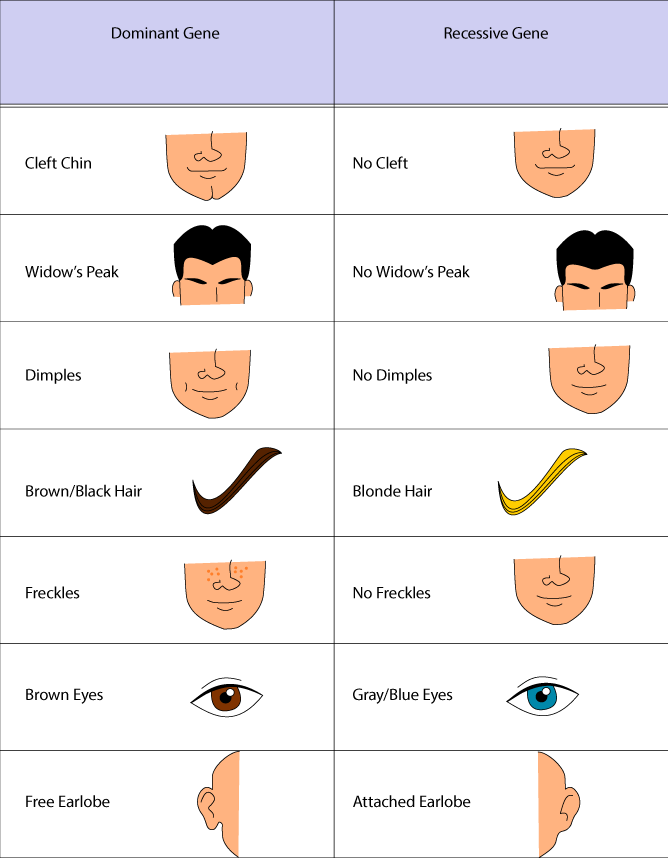
Lithuim: Dominant traits aren’t preferentially passed along between generations, they just express more strongly if they are passed down.
If a dominant gene is rare, it may continue to be rare unless there’s some selective pressure killing off animals without it.
whythecynic: “Dominant” and “recessive” simply describe how two *alleles* interact with each other. A dominant allele may be *disadvantageous*- in which case it would slowly die out. It might simply be rarer- when most of the population has recessive alleles, the dominant allele doesn’t increase in number as quickly.
That’s the simple description- let’s look at it closely!
## Alleles
The DNA of humans (like most animals) is paired up. We have two copies of each gene. Each copy doesn’t have to be the same, too, and we can have two different versions of the same gene.
Each version of a gene is called an *allele*.
## Dominance
When an allele is *dominant*, the organism takes on that trait even if it has another *recessive* allele. For example, there are 3 alleles that determine your ABO blood group: A, B, and O. A and B are co-dominant, and O is recessive.
So if you have one A allele and one O allele, your blood type would be A. A is dominant over O. Similarly, B is dominant over O, and having one B and one O allele would give you a B blood type.
## Frequency
Nevertheless, the O blood type- two O alleles- is much more common in human populations. Why?
In this case, having A/B/AB/O blood types doesn’t really affect your life. You wouldn’t expect someone with an AB blood type to be more successful in life than someone with O, for example.
Thus over the generations, there isn’t any pressure that makes people with O blood less successful. So if a population starts out with a lot of O blood people, chances are that two people meeting and having kids will both be O type- and all their kids will be O type.
So it just happened that we started out with relatively lots of O type people, and the proportion stayed that way!
The same goes for having many fingers on each hand. It’s simply much more common to find 5-fingered people, even though having 6 fingers is a dominant trait.
## More reading
http://genetics.thetech.org/ask-a-geneticist/polydactyly
http://www.biology.arizona.edu/human_bio/ABO_Crosses.html
FCCCaffeineQueen: When you are working with a large population, it ends up working out that the dominant *allele* (copy of a gene) doesn’t become more common unless it gives a survival/reproductive advantage.
If you are already familiar with Punnet squares, Khan Academy has a whole group of videos to explain population genetics: https://www.khanacademy.org/science/biology/her/heredity-and-genetics/v/hardy-weinberg
Concise_Pirate: Yer not alone in askin’, and kind strangers have chimed in:
1. [ELI5: if blue eyes are recessive then how did they manage to originally spread to so many people? ](https://www.reddit.com/r/explainlikeimfive/comments/69mgc8/eli5_if_blue_eyes_are_recessive_then_how_did_they/) ^(_39 comments_)
1. [ELI5:Why haven’t dominant genes completely replaced recessive genes through evolution? ](https://www.reddit.com/r/explainlikeimfive/comments/3w387a/eli5why_havent_dominant_genes_completely_replaced/) ^(_19 comments_)
exotics: They aren’t. Some recessive traits have advantages and therefore are more common. In nature this might even result in animals with the dominant trait dying off and then you never see that trait again.
Some genes are simpler than others and it’s just one thing or another. Other things require several genes to control, it’s not a case of this or that.. but could be this, that, the other, or the other.. and so forth. A good example of this might be horse color. Chestnut is the most recessive color but very common, White (which is extremely rare) is the most dominant color of all.. grey is otherwise thought of as a dominant color (and I note grey and white are not the same).. but of course you can also have black, bay, buckskin, and a ton of other colors in horses.
When you breed two things together if they both have recessive genes that is the only gene the offspring can get.. simple… with dominant genes the genotype of the parents is more complicated.. both parents might have 2 dominant genes. One might have 2 dominant genes and one might have 1 dominant gene and 1 recessive.. or both might have 1 dominant gene and one recessive.. ONLY in the last pair would the offspring have a chance of getting 2 recessive genes and therefore it would have the recessive trait. It’s a 1 in 4 chance of that.. but of course it won’t happen in the other scenarios.
red_leader2101: Certain phenotypes (appearances) may be less desirable to mates (e.g. dwarfism) even though it may be dominant. In addition, these traits could reduce the survivability of the individual. Overall, natural or mate selection does not favor the trait in the current environment.
a1fredo33: In this case he is asking why brown eyes are more dominant in their genetic expression (phenotype) than blue eyes. Whether or not brown eyes are selected for. I can not answer this but I know what he is asking. And now I am wondering. Darwinism doesn’t appear to be the answer for me but I’m open minded.
needles_in_the_dark: I suggest googling the definitions of “dominant” and “recessive” and the answer should be pretty obvious.
OverPot: conforming/obeyin is engrained as a child take santa for example. obey blindly and you get stuff! disobey and you get nothing.